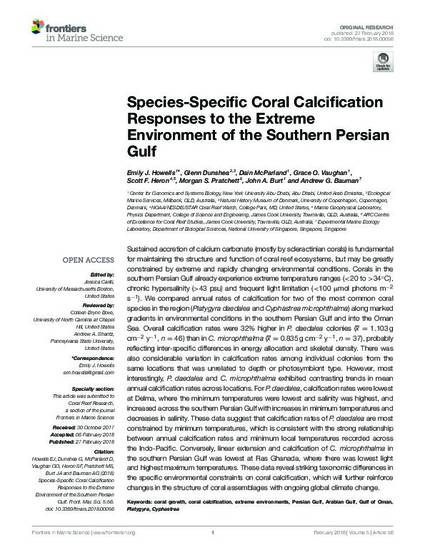
- coral growth,
- coral calcification,
- extreme environments,
- Persian Gulf,
- Arabian Gulf,
- Gulf of Oman,
- Platygyra,
- Cyphastrea
Sustained accretion of calcium carbonate (mostly by scleractinian corals) is fundamental for maintaining the structure and function of coral reef ecosystems, but may be greatly constrained by extreme and rapidly changing environmental conditions. Corals in the southern Persian Gulf already experience extreme temperature ranges (<20 to >34°C), chronic hypersalinity (>43 psu) and frequent light limitation (<100 μmol photons m−2 s−1). We compared annual rates of calcification for two of the most common coral species in the region (Platygyra daedalea and Cyphastrea microphthalma) along marked gradients in environmental conditions in the southern Persian Gulf and into the Oman Sea. Overall calcification rates were 32% higher in P. daedalea colonies (x = 1.103 g cm−2 y−1, n = 46) than in C. microphthalma (x = 0.835 g cm−2 y−1, n = 37), probably reflecting inter-specific differences in energy allocation and skeletal density. There was also considerable variation in calcification rates among individual colonies from the same locations that was unrelated to depth or photosymbiont type. However, most interestingly, P. daedalea and C. microphthalma exhibited contrasting trends in mean annual calcification rates across locations. For P. daedalea, calcification rates were lowest at Delma, where the minimum temperatures were lowest and salinity was highest, and increased across the southern Persian Gulf with increases in minimum temperatures and decreases in salinity. These data suggest that calcification rates of P. daedalea are most constrained by minimum temperatures, which is consistent with the strong relationship between annual calcification rates and minimum local temperatures recorded across the Indo-Pacific. Conversely, linear extension and calcification of C. microphthalma in the southern Persian Gulf was lowest at Ras Ghanada, where there was lowest light and highest maximum temperatures. These data reveal striking taxonomic differences in the specific environmental constraints on coral calcification, which will further reinforce changes in the structure of coral assemblages with ongoing global climate change.
Available at: http://works.bepress.com/andrew-bauman/52/

The Supplementary Material for this article can be found online at: https://www.frontiersin.org/articles/10.3389/fmars.2018.00056/full#supplementary-material